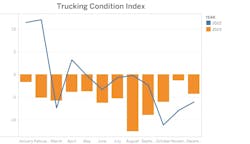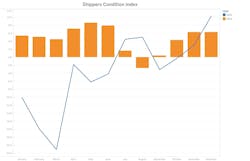While trucking faced a challenging year in 2023, an industry-leading analyst says the good news is the market probably won’t get worse in 2024.
FTR Transportation Intelligence recently finalized its market conditions indexes for December. The indexes found that the trucking market faced challenging conditions through the end of last year, while the shipping market maintained exceptional health.
“We finally see indications that larger carriers are no longer absorbing the bulk of driver capacity displaced by failing small carriers, suggesting a steady tightening of capacity that eventually could spark a turn in the market,” Avery Vise, FTR’s VP of trucking, said. “If the recent upturn in diesel prices continues, the capacity drain among small carriers might accelerate. Even so, the industry will need stronger freight demand, and we still don’t see any significant inflection in volume until at least the second half of this year.”
The Trucking Conditions Index uses a mixture of freight volumes, freight rates, fleet capacity, fuel prices, and financing costs to measure industry health. Positive numbers signify good health, and negative numbers signify bad health. The FTR Shippers Condition Index uses freight demand, freight rates, fleet capacity, and fuel price.
FTR’s Trucking Conditions Index for December was -4.31. It had fallen by nearly 3 points from -1.35 in November. Besides November, however, the December index represents the least negative overall trucking market conditions since May.
The fall between November and December was largely due to a higher cost of capital and a deterioration in freight rates, according to FTR.
See also: Class 8 orders and spot rates: Early data is showing a dim end to 2023
How might trucking fare in 2024?
FTR’s outlook for carriers’ conditions through 2024 remains pessimistic. The company expects more below-neutral market conditions for the year. The outlook for shippers in 2024 remains positive, though less favorable than it was in 2023.
“Our forecast is that it’s not going to get any better for shippers and probably not any worse for trucking companies,” Vise told FleetOwner. “We see sort of a prolonged kind of strengthening of the market. In other words, a long period of time in which not only do we start to see more freight growth because we’ve been very stagnant (we essentially were flat year over year in overall truck loadings; we’re expecting less than 1% growth this year), but, even more to the point, [we'll start to see] more capacity to come out of the system.”
One major factor in the overall poor health of trucking has been excess capacity. As lowering freight volumes and rates continue to push carriers out of business, the excess capacity should eventually meet with demand.
“It is fair to say that, on a snapshot basis, the overall market has plenty of drivers, and we have low utilization relative to at least the last 10 years,” Vise continued. “That is, at this point, working its way out gradually, and we only see a sort of gradual recovery in the utilization and a gradual increase in spot rates.”
FTR expects slow signs of recovery later this year, assuming no major industry disruptions occur.
“It’s going to be a very smooth kind of gradual recovery, absent some sort of inflection point,” Vise said.
The start of the year was a mixed bag. For example, ACT Research predicted a rise in the production and sales of Class 8 vehicles in February, and DAT Freight & Analytics reported a slow, cold truckload market for February.
Trucking in 2024 is plagued by flat freight movement demand, dropping rates, and low load-to-truck ratios. Dean Croke, principal analyst for DAT, said that if rates continue to drop, it could lead to a dramatic drop in capacity and subsequent spike in rates.
“This is sort of a best-case scenario for those that can stay in the business, worst-case scenario for those that have to fold up and leave,” Croke told FleetOwner. “I think the one thing that is clear is that, when this market turns, there will be fewer trucks. There’s no question about that. That’s a dangerous game for shippers because it could be a sharp correction.”
However, this light at the end of the tunnel might be lengthening trucking’s excess capacity. The more that carriers hold out in hopes of higher rates, the longer it will take for trucking capacity to meet demand.
“I think some of it is psychological, especially among smaller carriers. They’ve gotten this notion that ‘what goes down comes up ... And I want to be around for those rates,’” Vise told FleetOwner. “Now the problem is, if everybody does that, we don’t lose capacity fast enough.”
Carriers struggled in both 2023 and 2022
FTR’s Trucking Conditions Index was negative every month in 2023. The company found the worst industry health conditions in August, when the index fell to -12.54. The best month was November, at -1.35.
According to past indexes, 2022 also turned out to be a difficult year for trucking. While the year had started out strong—with indexes as high as 11.46 in January 2022 and 12.06 in February—the index quickly dropped to -7.38 in March. From May 2022 to this latest update, the index remained negative.
Shippers fared much better in 2023 than 2022
After the trucking index began its downward turn, the shipping index began to rise. Signifiers of health for shippers can often be the opposite of those for trucking. For example, while falling freight rates can be bad news for trucking, it can be beneficial for shipping.
“Those two tend to be inverses of each other,” Vise told FleetOwner. “The difference is that trucking has been consistently negative.”
After a significant low of -23.1 in March 2022, the Shippers Condition Index began a general upward trend. The index remained positive from November 2022 through July 2023, and from September 2023 onward.
About the data
The indexes come from FTR’s February Trucking Update and Shippers Update. Both updates provide industry forecasting based on a variety of market conditions, from freight rates to overall U.S. economic trends. The reports also included the Trucking Conditions Index and Shippers Condition Index, which represent the health of the respective industries as of December.
See also: Trucking congestion costs set industry record, topping $94.6 billion
“We are seeing firmer freight demand than our forecasts had been indicating, and that will start chipping away at the favorable capacity utilization and rate environments that have benefited shippers for some time,” Vise said. “Shippers should start mulling over how they will respond to a freight market that is considerably more balanced and, therefore, more susceptible to volatility.”
About the Author
Jeremy Wolfe
Editor
Editor Jeremy Wolfe joined the FleetOwner team in February 2024. He graduated from the University of Wisconsin-Stevens Point with majors in English and Philosophy. He previously served as Editor for Endeavor Business Media's Water Group publications.



